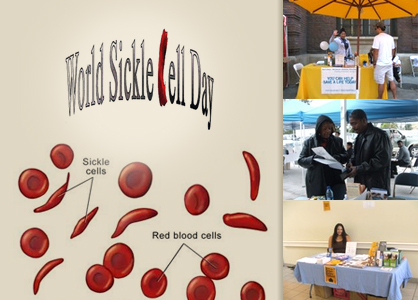Honoring World Sickle Cell Day: Myths and truths about sickle cell
You arrive at the emergency room, feeling as if glass shards are running through your veins. You are in excruciating pain, desperate for relief. Unfortunately, the ER nurse does not believe that you have sickle cell disease, but rather thinks you are a drug addict looking for a morphine high. You are denied pain medication.
This is an all-too-common experience for people with sickle cell disease. That’s where organizations such as the African American Blood Drive and Bone Marrow Registry for Sickle Cell Disease Awareness (AA4SCDA), a grassroots group that advocates for patients with sickle cell, enters.
“It’s about being there for a person when they are in the hospital, in case you get with a doctor or nurse that really doesn’t understand sickle cell. So we can come in and be the voice,” Nita Thompson, chair of the AA4SCDA, said.
Sickle cell disease, the most common genetic disease worldwide, is a condition in which red blood cells become deformed, hard and sticky when oxygen tension in the blood lowers. The disease takes its name from the cells’ warped shape – similar to a sickle used to cut wheat.
When the hardened cells pass through small blood vessels, they stick together and clog the tubes. This blockage cuts off the supply of oxygen and vital nutrients, leading to pain and a host of other complications: strokes, a blocked spleen, leg ulcers, blindness and even death.
The disorder kills roughly half a million people globally each year. A single sickle cell gene, however, can be advantageous, as it protects against malaria. (The disease is recessive, so those diagnosed with SCD have two sickle cell genes.) The inheritance of one sickle cell gene therefore has increased in areas where malaria is prominent. SCD patients, though, are not resistant to malaria.
There are few treatment options for SCD patients. Most turn to pain medication, from over-the-counter drugs to serious narcotics. Bone marrow and cord blood, both of which can be donated, are a curative – not a cure – for sickle cell. Finding bone marrow matches is difficult; only 30 percent of family members will match another family member. Thompson, therefore, urges the general public to register their bone marrow, especially in honor of World Sickle Cell Day, this June 19.
“The reason it is a curative and not a cure is because it is not like a pill or a shot that every patient can get and they will be cured of it,” Thompson explained. “A lot of people never match and never donate. They are willing, but don’t match. Other people won’t register and don’t register.”
Thompson also pleas for people to donate blood, as some patients need blood transfusions every two to four weeks for the rest of their lives. Many do not get the blood they need and others receive only a partial transfusion, because there is simply not enough blood to go around.
Formed out of a parent support group that started in 1992, the AA4SCDA came together in order to educate the public about the disease. The organization continues to dispel misconceptions about the disorder.
“We got tired of sitting around talking about our children’s challenges and decided to get active and do something,” Thompson revealed. “Our mission is to inform the public about sickle cell disease … to educate the public about the reality of sickle cell … (There’s) a lot of untruths.”
It is often thought that only black people inherit sickle cell, but in reality, the disease can affect a person of any race.
The parent support group’s first task was to network with hospitals to conduct blood drives. After discovering that most children diagnosed with sickle cell will need at least one blood transfusion before the age of 11, the parents started campaigns to raise awareness and encourage blood donations. Since then, the AA4SCDAhas successfully compelled legislators to pass a California State Assembly bill to help the sickle cell community by making donations of infant cord blood standard.
The first World Sickle Cell Day in 2009 was too new to draw a lot of attention, but it has taken off in the last two years. Today the organization’s literature is sent around the globe, and its website is a hub for organizations to post their celebratory events.
A sickle cell crisis – when pain flares up – can strike at anytime.
“It’s like you’re on a highway, and all of a sudden, the brakes come on and all traffic stops,” Thompson described. “There’s no flow. That’s what happens in a person’s body. Nothing gets past … Everything is blocked up. When that happens, it creates pain.”
The pain can continue for days.
“You can have pain anywhere in the body where the blood vessels are, anywhere where the blood can get clogged up—that’s anywhere (in the body),” Thompson disclosed.
People who suffer from sickle cell crises also struggle with the side effects these crises have on their lives. Children labor to make up their schoolwork, teens drop out of high school, and adults lose their jobs.
“It’s very, very hard. I’m told that people do not understand,” Thompson said.
For more information, visit the AA4SCDA's website.
Tagged in: lux exclusives, philanthropy, disease, disorder, aa4scda, blood, world sickle cell day, sickle cell,

Purple Neon/LadyLUX via AA4SCDA



